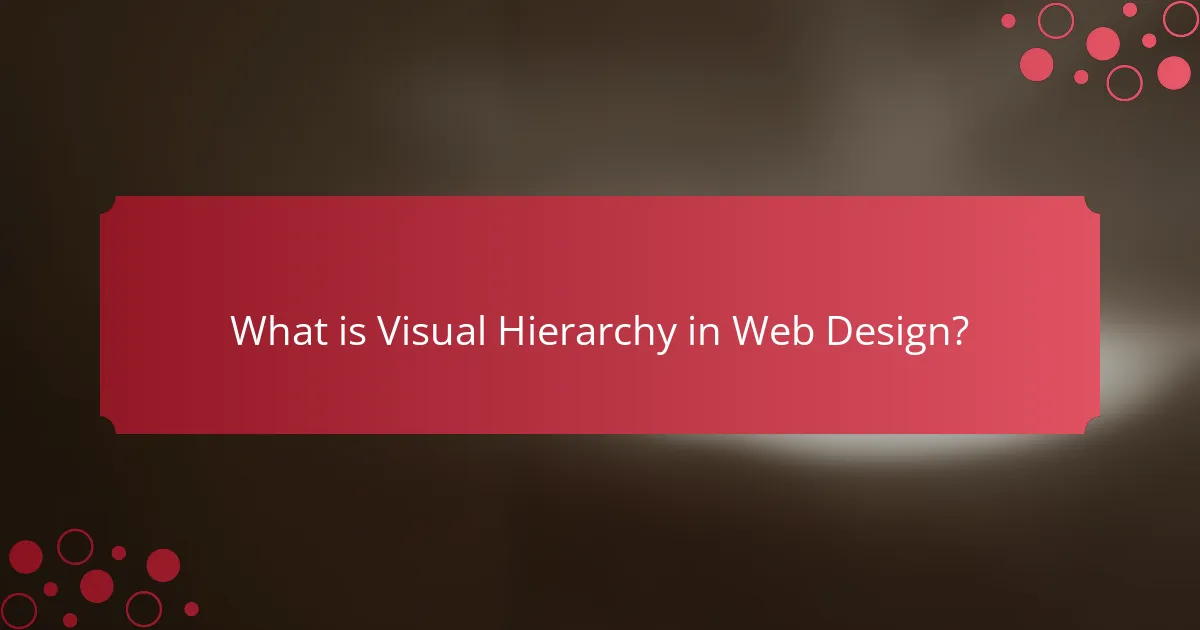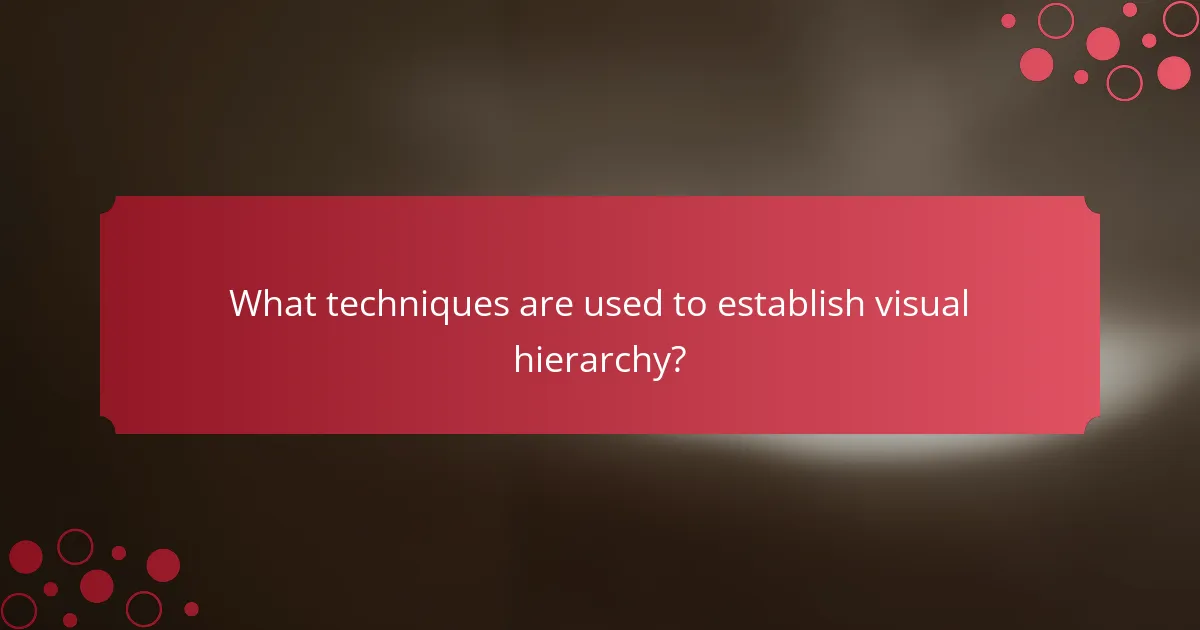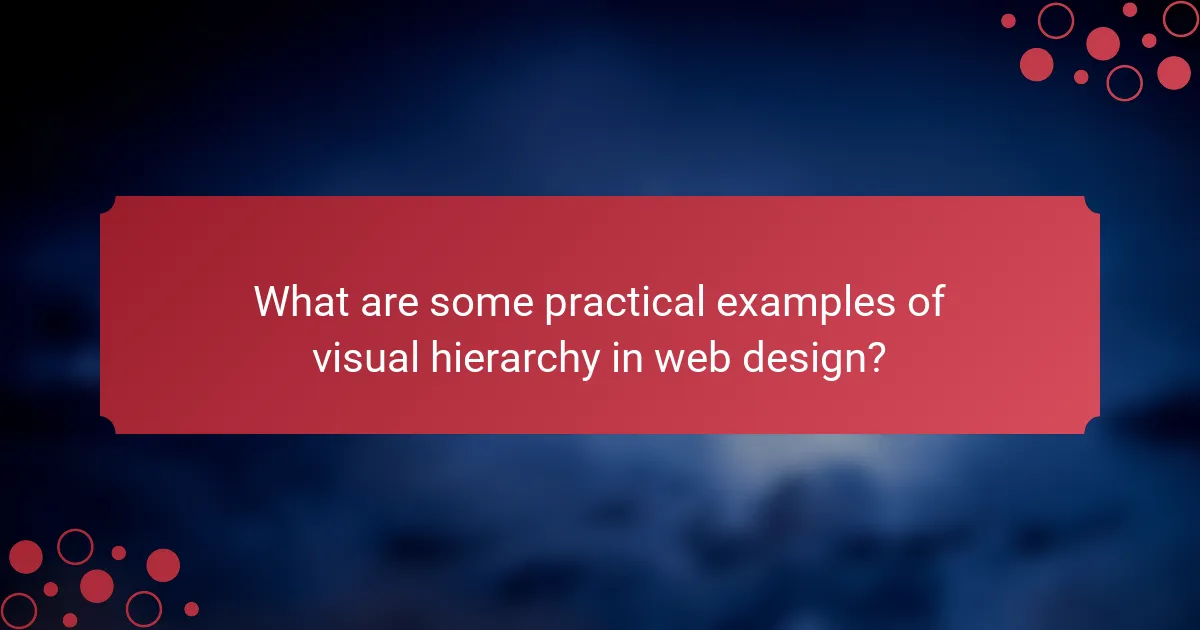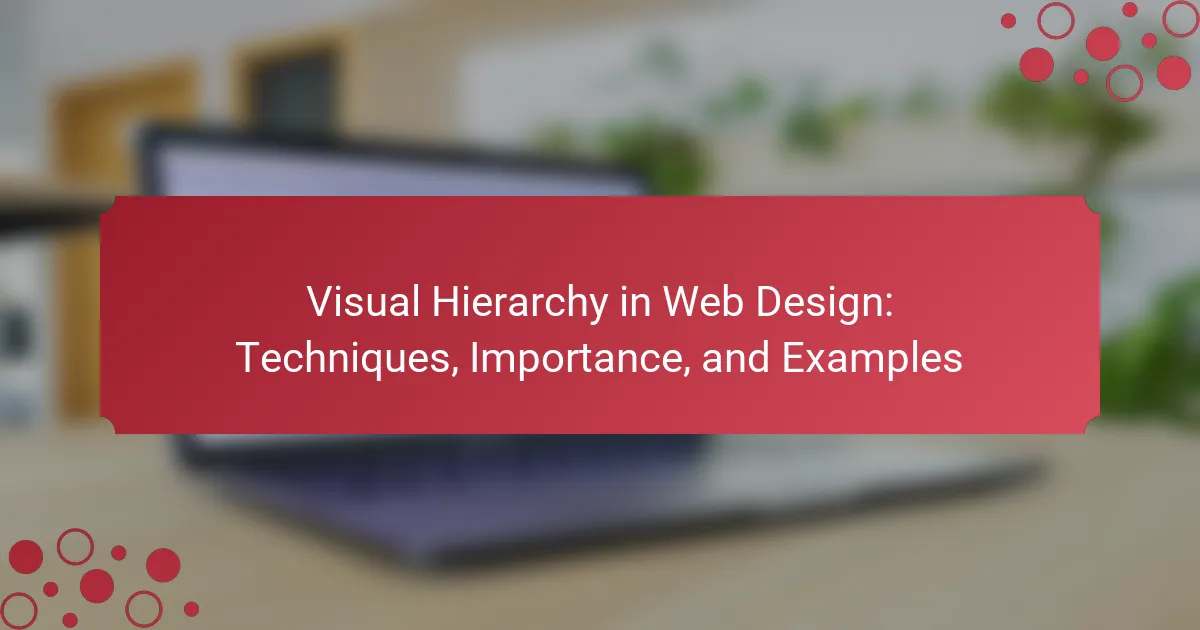Visual hierarchy in web design is the strategic arrangement of elements that directs user attention and enhances navigation. This concept is essential for improving usability and user experience on websites. Key techniques for establishing visual hierarchy include size, color, contrast, alignment, proximity, and whitespace, each playing a crucial role in guiding users through content. Practical examples demonstrate how contrasting colors, font sizes, and strategic placement of images can effectively highlight important information and encourage user interaction. Understanding and applying these principles is vital for creating clear, organized, and visually appealing web designs.

What is Visual Hierarchy in Web Design?
Visual hierarchy in web design refers to the arrangement of elements to guide user attention. It helps users navigate content effectively. Designers achieve visual hierarchy through size, color, contrast, and spacing. Larger elements typically draw more attention than smaller ones. Bold colors can highlight important information. Proper spacing ensures clarity and organization. Studies show that users tend to focus on the most prominent elements first. This principle is crucial for enhancing usability and user experience on websites.
How does visual hierarchy influence user experience?
Visual hierarchy significantly influences user experience by guiding users’ attention to the most important elements on a page. It employs size, color, contrast, and spacing to create a structured layout. Effective visual hierarchy helps users navigate content easily. Research indicates that users spend 80% of their time looking at information above the fold. A clear hierarchy reduces cognitive load, enabling quicker decision-making. Studies show that well-structured designs can increase user satisfaction by up to 50%. Therefore, visual hierarchy is essential for enhancing usability and engagement in web design.
What are the key principles of visual hierarchy?
The key principles of visual hierarchy are the arrangement and presentation of elements to guide viewer perception. Size plays a significant role; larger elements attract more attention. Color contrast enhances visibility and draws focus to important sections. Alignment organizes content and creates a clean layout. Proximity groups related items, making information easier to digest. Whitespace is essential for breathing space, preventing clutter. Consistency in style fosters familiarity and aids navigation. These principles are foundational in effective web design. They help users navigate content intuitively and improve overall user experience.
How does visual hierarchy guide user navigation?
Visual hierarchy guides user navigation by organizing content in a way that prioritizes information. It uses size, color, contrast, and placement to draw attention to key elements. Larger elements typically indicate importance, while smaller ones suggest lesser significance. Color contrast can emphasize calls to action, making them stand out. Proper placement can lead users through a logical flow of information. For example, a prominent headline at the top of a page captures initial interest. Studies show that users scan web pages in an F-pattern, highlighting the need for effective visual hierarchy. This pattern reinforces the importance of structuring content to align with user behavior, ultimately enhancing navigation efficiency.
Why is visual hierarchy important in web design?
Visual hierarchy is important in web design because it guides users’ attention effectively. It helps prioritize information, making content easier to digest. A well-structured visual hierarchy enhances user experience by directing focus to key elements. Studies show that users scan web pages in an F-pattern, indicating the need for clear hierarchy. Effective use of size, color, and spacing can significantly improve readability. In fact, 70% of users prefer websites that are visually appealing and easy to navigate. This demonstrates the direct correlation between visual hierarchy and user engagement. Ultimately, a strong visual hierarchy ensures that users find the information they need quickly and efficiently.
What impact does visual hierarchy have on conversion rates?
Visual hierarchy significantly impacts conversion rates. Effective visual hierarchy guides users’ attention to key elements on a webpage. This structured arrangement improves user experience and facilitates decision-making. Studies show that websites with clear visual hierarchy can increase conversion rates by up to 200%. For example, a well-placed call-to-action button can lead to higher engagement. Additionally, contrasting colors and sizes enhance visibility and draw focus. This strategic design approach ultimately leads to improved sales and user satisfaction.
How does visual hierarchy affect content comprehension?
Visual hierarchy significantly enhances content comprehension by guiding the viewer’s attention through structured design elements. It organizes information in a way that prioritizes key messages. This prioritization helps users quickly identify the most important parts of the content. Studies show that users spend 80% of their time looking at the visual elements on a page. Effective use of size, color, and spacing creates a clear path for the eye. This clarity reduces cognitive load, allowing for quicker understanding. Research indicates that well-structured visual hierarchy can improve retention of information by up to 38%. Thus, a strong visual hierarchy is essential for effective communication in web design.

What techniques are used to establish visual hierarchy?
Techniques to establish visual hierarchy include size, color, contrast, alignment, proximity, and whitespace. Size influences importance; larger elements attract more attention. Color can differentiate elements and guide focus. High contrast between text and background enhances readability. Proper alignment creates a clean layout, leading the viewer’s eye naturally. Proximity groups related items, establishing relationships. Whitespace helps to separate elements, reducing clutter. These techniques are essential for effective communication in web design.
How can color be used to create visual hierarchy?
Color can be used to create visual hierarchy by differentiating elements based on their importance. By using contrasting colors, designers can draw attention to key components. For example, a bright color can highlight a call-to-action button. Darker colors may recede, indicating less importance. Studies show that color contrast improves user engagement and comprehension. The use of color can also establish relationships between elements. Similar colors can group related items together. This technique helps users navigate content more intuitively. Overall, color is a powerful tool in establishing a clear visual hierarchy.
What role does contrast play in visual hierarchy?
Contrast plays a crucial role in visual hierarchy by enhancing the differentiation between elements. It helps guide the viewer’s attention to the most important parts of a design. High contrast can highlight key information, making it more noticeable. For example, using bold text against a light background increases readability. Studies show that designs with effective contrast improve user engagement rates. Effective contrast can also establish a clear focal point within a layout. This allows users to navigate content more intuitively. Thus, contrast is essential for creating an effective visual hierarchy in web design.
How can color psychology influence user perception?
Color psychology can significantly influence user perception by evoking emotional responses and guiding behavior. Different colors are associated with specific feelings; for example, blue often conveys trust and calmness, while red can evoke excitement or urgency. Research indicates that 90% of snap judgments about products are based on color alone, emphasizing its impact on first impressions. A study by Satyendra Singh in the journal “Management Decision” found that color increases brand recognition by up to 80%. This demonstrates how effective color choices can shape user engagement and decision-making. In web design, using appropriate colors can enhance usability and improve conversion rates.
What role does typography play in visual hierarchy?
Typography establishes visual hierarchy by influencing how information is perceived and understood. It does this through font size, weight, and style. Larger and bolder fonts attract attention and denote importance. Conversely, smaller or lighter fonts suggest secondary information. The use of different typefaces can also create contrast, guiding the viewer’s eye through the content. Consistency in typography enhances readability and comprehension. Research indicates that effective typography can improve user engagement by 25% (source: Nielsen Norman Group). Thus, typography is crucial in organizing content and directing focus within web design.
How do font size and weight affect emphasis?
Font size and weight significantly affect emphasis in text. Larger font sizes draw more attention than smaller sizes. They signal importance and hierarchy in web design. Similarly, bolder font weights create a stronger visual impact. This makes the text stand out more than regular weights. Research indicates that users perceive larger and bolder text as more significant. A study by the Nielsen Norman Group found that users read larger text more quickly. This supports the idea that size and weight enhance readability and emphasis.
What are the best practices for using typography in web design?
Best practices for using typography in web design include selecting readable fonts, maintaining a clear hierarchy, and ensuring proper spacing. Readable fonts enhance user experience by making text easy to read. A clear hierarchy guides users’ attention through varied font sizes and weights. Proper spacing, including line height and letter spacing, improves legibility. Consistency across the website reinforces brand identity. Limiting font choices to two or three enhances visual coherence. Using contrast between text and background increases visibility. Finally, responsive typography ensures readability across devices. These practices collectively enhance user engagement and comprehension.
How can layout and spacing enhance visual hierarchy?
Layout and spacing can significantly enhance visual hierarchy by organizing content effectively. A well-structured layout guides the viewer’s eye through the design. Spacing creates separation between elements, making them easier to distinguish. Larger elements often attract more attention, establishing a focal point. Consistent alignment of elements leads to a more cohesive appearance. According to research by the Nielsen Norman Group, effective spacing improves readability and user engagement. Proper layout and spacing lead to increased comprehension of content. This structured approach ultimately enhances the overall user experience on a website.
What are effective strategies for using white space?
Effective strategies for using white space include creating visual balance and enhancing readability. White space helps to separate different elements on a page. This separation allows users to focus on individual components without distraction. Additionally, white space can guide user navigation through a website. It directs attention to key areas, such as calls to action. Research shows that adequate white space can improve comprehension by 20%. This statistic highlights the importance of white space in web design. Using white space strategically can lead to a more engaging user experience.
How do grid systems contribute to visual hierarchy?
Grid systems establish a structured layout that enhances visual hierarchy. They create a consistent framework for organizing content. This organization allows designers to prioritize elements based on importance. For example, larger areas can highlight key messages. Grid systems also guide the viewer’s eye through a logical flow. This flow improves readability and comprehension of information. Research indicates that well-structured layouts lead to better user engagement. Effective use of grids can increase the likelihood of users absorbing critical content.

What are some practical examples of visual hierarchy in web design?
Practical examples of visual hierarchy in web design include the use of contrasting colors for headings and body text. This contrast helps guide the viewer’s attention. Large font sizes for titles and smaller sizes for subtitles create a clear distinction.
Images placed strategically can draw focus to important content. White space around elements enhances readability and emphasizes key areas. Buttons designed with vibrant colors stand out, encouraging user interaction.
The arrangement of elements in a grid layout can organize information logically. Icons can represent actions, making navigation intuitive. Consistent alignment of text and images fosters a cohesive look.
What are notable websites that effectively use visual hierarchy?
Notable websites that effectively use visual hierarchy include Apple, Dropbox, and Airbnb. Apple’s website highlights products with large images and clear typography. This approach draws attention to key features and calls to action. Dropbox uses a clean layout with contrasting colors to guide users through their services. This enhances usability and engagement. Airbnb employs a structured design with prominent images and intuitive navigation. This helps users easily find listings and explore options. Each of these websites demonstrates effective visual hierarchy through strategic design choices.
How do these examples implement visual hierarchy techniques?
These examples implement visual hierarchy techniques by strategically using size, color, and layout. Larger text draws attention to headings, establishing a clear focal point. Contrasting colors differentiate elements, guiding the viewer’s eye through the content. Consistent spacing between sections enhances readability and organization. Visual elements, such as images and icons, reinforce important information. Alignment of text and images creates a structured flow. These techniques ensure users can navigate the content intuitively. Research indicates that effective visual hierarchy improves user engagement and comprehension.
What can be learned from these successful designs?
Successful designs teach the importance of visual hierarchy in guiding user attention. They demonstrate how layout influences user experience. Effective use of contrast highlights key elements. Consistent typography improves readability and brand recognition. Strategic placement of images can enhance storytelling. Color schemes create emotional responses and establish brand identity. User testing reveals preferences for intuitive navigation. Analyzing these designs can inform future projects for better engagement and conversion rates.
How can designers improve their understanding of visual hierarchy?
Designers can improve their understanding of visual hierarchy by studying design principles and applying them in practice. Familiarizing themselves with concepts such as contrast, alignment, and proximity enhances their skills. Utilizing tools like wireframes and mockups can help visualize layout and structure. Analyzing successful designs provides insights into effective hierarchy application. Engaging in feedback sessions with peers allows for constructive critique and learning. Regularly revisiting design basics reinforces foundational knowledge. Experimenting with different layouts and styles promotes practical understanding. Keeping updated with design trends can inspire innovative approaches to visual hierarchy.
What resources are available for learning about visual hierarchy?
Books such as “Don’t Make Me Think” by Steve Krug provide foundational insights into visual hierarchy. Online courses on platforms like Coursera and Udemy offer structured learning on design principles. Websites like Smashing Magazine feature articles and tutorials specifically focused on visual hierarchy. Design blogs often share case studies that illustrate effective use of visual hierarchy in web design. YouTube channels dedicated to design education provide visual demonstrations of hierarchy techniques. Adobe’s resources include guides and webinars on design best practices, including visual hierarchy. These resources collectively enhance understanding of visual hierarchy in web design.
What are some common mistakes to avoid in visual hierarchy?
Common mistakes to avoid in visual hierarchy include using inconsistent font sizes. Inconsistent sizes can confuse users about the importance of information. Another mistake is neglecting contrast between text and background. Low contrast makes text hard to read and diminishes its significance. Overloading a design with too many elements can also disrupt visual hierarchy. A cluttered layout can overwhelm users and obscure key messages. Additionally, failing to prioritize elements can lead to a lack of focus. Users may miss critical information if everything appears equally important. Lastly, ignoring whitespace is a frequent error. Adequate spacing helps to separate elements and enhances readability.
What tips can help in applying visual hierarchy effectively?
To apply visual hierarchy effectively, prioritize elements based on importance. Use size variations to indicate significance; larger elements attract more attention. Contrast colors to differentiate between primary and secondary information. Employ whitespace to create separation and improve readability. Align elements consistently to guide the viewer’s eye through the content. Utilize typography hierarchy by varying font sizes and weights for emphasis. Group related items together to create visual relationships. Follow the F-pattern layout, as studies show users scan pages in this manner.
Visual hierarchy in web design refers to the strategic arrangement of elements to guide user attention and improve navigation. The article explores key principles, such as size, color, contrast, and spacing, that influence user experience and comprehension. It highlights the importance of visual hierarchy in enhancing usability, increasing conversion rates, and facilitating effective communication. Techniques for establishing visual hierarchy, practical examples, and common mistakes to avoid are also discussed, providing a comprehensive understanding of how to implement these concepts effectively in web design.
